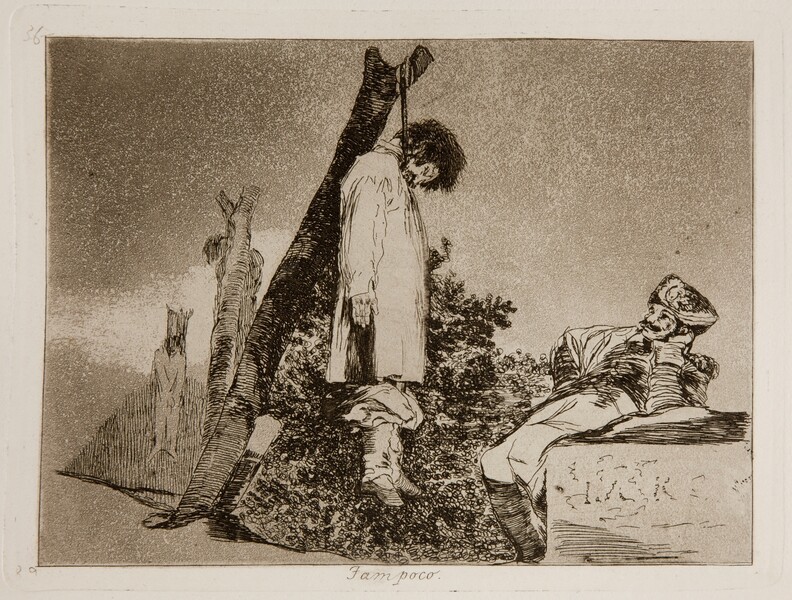- Cronología
- Ca. 1812 - 1815
- Dimensiones
- 157 x 208 mm
- Técnica y soporte
- Aguafuerte, aguatinta bruñida, punta seca, buril y bruñidor
- Reconocimiento de la autoría de Goya
- Undisputed work
- Ficha: realización/revisión
- 08 Dec 2010 / 07 Nov 2024
- Inventario
- 225
39 (on the lower left-hand corner)
See Sad presentiments of what must come to pass (Tristes presentimientos de lo que ha de acontecer).
The title was originally printed as Tan poco, although there are no surviving copies bearing this title as it was modified, erasing the n and writing the m in its place which is maintained in the definitive title.
The title was handwritten on the print by Goya in the first and only series that is known to have been printed at the time the works were created, which the artist gave to his friend Agustín Ceán Bermúdez. Therefore, the title was etched into the plate at a later date and left unchanged as of the first edition of the Disasters of War printed by the San Fernando Royal Academy of Fine Arts in Madrid in 1863, after the printing of the series in the possession of Ceán Bermúdez.
There are no surviving preparatory drawings for this print.
A Polish soldier sits calmly resting his head on his hand, contemplating the corpse of a hanged Spanish man with a serene, almost proud expression. The trousers of the dead man have fallen to his knees because his belt has been used in his own execution. Behind him there are other tree trunks from which more corpses are hung. As recorded by some travellers at the time, the dead bodies of hanged men were sometimes left hanging in the trees as a clear example to others.
Goya makes interesting use of aquatint in this work, leaving the central section of the print in white in order to highlight the line of trees and hanged men, perhaps suggesting that it continues beyond the compositional space.
Polish soldiers were employed in the French troops as they were famous for their merciless, bloodthirsty nature and coldness when confronting the enemy. Goya captures this is the print, depicting in great detail the face of the soldier who contemplates his macabre work with pleasure.
Despite the fact that the garrotte had replaced all other methods of execution from October 1809 onwards, it was common for French soldiers to hang Spaniards who were found in possession of a weapon. It was a quick execution method that avoided the bureaucratic processes associated with the death penalty by garrotte to which prisoners were supposed to be subjected.
Nature once again is complicit in the scene of violence and horror: the tree trunks on which the Spaniards are hanged seem dry, lifeless and capable of taking the lives of others.
The title of the print expresses the painter's perplexity: as in the case of print no. 34, On account of a knife (Por una navaja) the artist once again cannot explain to himself the brutality and inhumanity of the act he depicts. Similarly, in print no. 35 Goya underlines the banal nature of blame by plainly stating that One can't tell why (No se puede saber por qué).
This work shows that the artist was familiar with the work The Great Miseries of War (Les Grands Misères de la guerre) by Jacques Callot (Nancy, 1592 - Nancy, 1635) and in particular print no. 11, entitled The Hanging (La Pendaison). It shows a large tree in the centre of the composition from which numerous corpses hang, executed before the eyes of the army and the people. However, Goya varies the scale in his work, bringing the viewer closer to the figures so that we can see their faces and be moved by the atrocity of this act.
The plate is stored in the National Chalcography (cat. 287).
-
Goya. Drawings, Etchings and LithographsGoya. DrawingsLondon1954from June 12th to July 25th 1954pp. 8-10, cat. 59
-
De grafiek van GoyaRijksmuseum RijksprentenkabinetAmsterdam1970from November 13th 1970 to January 17th 1971cat. 76
-
Goya. Das Zeitalter der Revolucionen. Kunst um 1800 (1980 – 1981)Hamburger KunsthalleHamburg1980cat. 86
-
Goya and the espirit of enlightmentThe Metropolitan Museum of ArtNew York1989scientific directors Alfonso E. Pérez Sánchez and Eleanor A. Sayre. From May 9th to July 16th 1989. Exhibited also in the Boston Museum of Fine Arts, from January 18th to March 26th 1989cat. 88
-
Francisco de Goya: Maleri, Tegning, GrafikkNasjonalgallerietOslo1996from 10th to April 14th 1996cat. 140
-
Francisco de GoyaMuseo d'Arte ModernaLugano1996exhibition celebrated from September 22nd to November 17th.p. 153, cat. 36
-
Francisco Goya. Sein leben im spiegel der graphik. Fuendetodos 1746-1828 Bordeaux. 1746-1996Galerie KornfeldBern1996from November 21st 1996 to January 1997cat. 122
-
Francisco Goya. Capricci, follie e disastri della guerraSan Donato Milanese2000Opere grafiche della Fondazione Antonio Mazzottacat. 116
-
Goya. Opera graficaPinacoteca del Castello di San GiorgioLegnano2006exhibition celebrated from December 16th 2006 to April 1st 2007p. 69
-
Goya en tiempos de guerraMuseo Nacional del PradoMadrid2008consultant editor Manuela B. Mena Marqués, from April 14th to July 13th 2008cat. 96
-
Goya et la modernitéPinacothèque de ParisParís2013from October 11st 2013 to March 16th 2014cat. 75
-
Goya: Order and disorderMuseum of Fine ArtsBoston2014cat. 199
-
Madrid2017
-
Goya, grabadorMadridBlass S.A.1918cat. 138
-
Goya engravings and lithographs, vol. I y II.OxfordBruno Cassirer1964cat. 156
-
Vie et ouvre de Francisco de GoyaParísOffice du livre1970cat. 1051
-
Goya y el espíritu de la IlustraciónMadridMuseo del Prado1988pp. 303-304, cat. 88
-
Catálogo de las estampas de Goya en la Biblioteca NacionalMadridMinisterio de Educación y Cultura, Biblioteca Nacional1996cat. 241
-
Goya. Die Kunst der FreiheitMunichVerlag C. H. Beck2000p. 151, fig. 56
-
El Libro de los Desastres de la GuerraMadridMuseo del Prado2000II, pp. 73-76
-
ParísPinacoteca de París2013p. 137
-
Goya: Order & DisorderBostonMuseum of Fine Arts Boston Publications2014p. 292
-
Goya. In the Norton Simon MuseumPasadenaNorton Simon Museum2016pp. 114-151
-
ZaragozaGobierno de Aragón y Fundación Bancaria Ibercaja2017p.271
